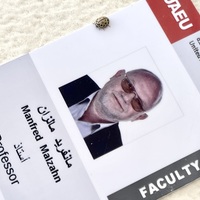
Lisa Rüth
Related Authors
Sebastiaan Faber
Oberlin College
Lucja Biel
University of Warsaw
Maria Luisa Carrio Pastor
Universitat Politècnica de València
David Seamon
Kansas State University
Armando Marques-Guedes
UNL - New University of Lisbon
Didier COSTE
Université Bordeaux-Montaigne
Frédérique Langue G.
Centre National de la Recherche Scientifique / French National Centre for Scientific Research
Manfred Malzahn
United Arab Emirates University
César Jesús Burgos Dávila
Universidad Autónoma de Sinaloa
Salvador Martí-i-Puig
Universitat de Girona
InterestsView All (9)










Uploads
Papers by Lisa Rüth
Inhalt
2 Definition und Entwicklung
2.1 Struktur eines Narcocorridos.
2.2 Unterschiede zwischen kommerziellen Narcocorridos und Auftragsarbeiten
2.2.1 Kommerzielle Narcocorridos
2.2.2 Auftragsarbeiten
3 Semantische Aspekte und ihr Verhältnis zur Realität
3.1 Das Bild des Narcos
3.2 Armut
3.3 Verhältnis zur Staatsgewalt
3.4 Moral und Loyalität
4 Sprachwissenschaftliche Betrachtungen
4.1 Synonymie
4.2 Bildhaftigkeit in Narcocorridos
4.2.1 Bildspenderbereich Fußball
4.2.2 Bildspenderbereich Frauen
4.2.3 Bildspenderbereich Reise
4.2.4 Bildspenderbereich Zoologie
5 Narcocorridos in der Gesellschaft – Erfolg und Funktion
Talks by Lisa Rüth
We would like to propose an empirical methodology integrating product- and process-based research. Our major research question is reflected in the concept of grammatical metaphor – i.e. semantic units mapped onto different grammatical units – which is investigated through the following techniques:
We use multi-layer annotation and alignment of a parallel corpus to identify grammatical shifts, e.g. aligned words which occur in nominal construction in one language and in clausal constructions in the other.
Eye-tracking helps identifying the elements in the source text that trigger processing problems which might result in grammatical shifts.
On the basis of keystroke-logging, the production process of the target text can be examined and the development of grammatical shifts can be tracked back.
In retrospective interviews, attention can be drawn to possible processing difficulties and problem solving strategies can be made conscious.
Comprehensibility tests show how acceptable a certain degree of grammatical metaphor is for the target audience and whether the conventions of the target language are adhered to.
Using thinking-aloud protocols, foci of attention (including processing problems and steps in solution finding) can be identified. Moreover, conscious processes are made explicit and can thus be differentiated from unconscious ones.
By using this combination of product- and process-oriented research, we obtain insights into the routes in unpacking (de-metaphorization) and repacking (re-metaphorization) meanings – and this even more densely compared to the source text (metaphorization). In addition, this methodology allows us to explain properties of translations that can be tracked in the process and to quantify specific patterns in the process of language understanding, transfer and production. This opens up new horizons for an integrated and empirical view on the translation process, the translation product and the translator himself.
Recently, corpus linguistic techniques have become available for parallel corpora with which equivalence relations can be empirically investigated. Within this context, the proposed poster presents an empirical investigation of shifts in equivalence on the basis of the English-German/German-English CroCo Corpus. This investigation takes the lexical, grammatical and semantic levels into account using multi-layer annotation and alignment. The annotation covers parts-of-speech, morphological analysis, phrase structure and syntactic functions; the alignment includes the word layer, syntactic functions, clauses and sentences.
The poster shows interesting results of a heuristic examination of peculiarities that can be found in the translations of the CroCo corpus, presenting them in the context of formal and dynamic equivalence. We explain how these peculiarities are queried in the corpus and how they affect the style of the target text. In this context, we present examples taken from our corpus of how formal equivalence "distorts the grammatical and stylistic patterns of the receptor language“ (Nida and Taber 1969) and how it results in a special kind of source language interference that causes the typical language use of the source language to "shine through" in the German translations (Teich 2003). In terms of dynamic equivalence, we show how shifts resulting from dynamic equivalence lead to different translation phenomena such as explicitation, simplification and normalization.In addition, we present possible explanations for shifts in grammatical metaphoricity and information structure (Steiner 2001, Fabricius-Hansen 1998). Some shifts are typical of certain registers while others can be seen as characteristic of translated language in general (Hansen 2003). Furthermore, we address the question of what changes resulting from a rearrangement of the assignment to grammatical functions rather than rearrangement of the word order can tell us about translation strategies. Finally, the combination of treebank-like annotation with multi-layer alignment enables new insights on the empirical investigation of the translation unit.
References
Fabricius-Hansen, C. (1998): "Information density and translation, with special reference to German – Norwegian – English." Pages 197–234 of: Johansson, S., & Oksefjell, S. (eds): Corpora and Cross-linguistic Research: Theory, Method and Case Studies. Amsterdam: Rodopi.
Hansen, S. (2003): The Nature of Translated Text. An Interdisciplinary Methodology for the Investigation of the Specific Properties of Translations. Saarbrücken: DFKI/Universität des Saarlandes.
Nida, E. & Taber, C. (1982): The Theory and Practice of Translation. Leiden: E.J. Brill.
Steiner, E. (2001): “Translations English-German: investigating the relative importance of systemic contrasts and of the text-type 'translation'.“
In: SPRIKreport (No. 7). Reports from the project "Languages in Contrast". Oslo: University of Oslo.
Teich, E. (2003): Cross-linguistic variation in system and text. A methodology for the investigation of translations and comparable texts. Berlin/New York: de Gruyter.
Vinay, J.-P./Darbelnet, J. (1958): Stylistique comparée du français et de l'anglais: méthode de traduction. Paris: Didier.
This poster presents an empirical investigation of shifts in equivalence on the basis of the English-German/German-English CroCo Corpus. The investigation takes the lexical, grammatical and semantic levels into account using multi-layer annotation and alignment. On this basis, grammatical and semantic shifts can be quantified and classified. Grammatical shifts (also called transpositions), for instance, frequently involve changes in tense, number, person, part-of-speech. In semantic shifts (or modulations), a change of perspective occurs between source and target texts. This may involve concretion, explication, negation of the opposite, (de-)passivization, etc. There are, however, changes which are characteristic of translated language: we find, for example, complex nominal phrases in the source language texts which are translated into verbal structures and new subordinate clauses in the translations – irrespectively of the translation direction and the register under investigation. This usually results in explicitation and simplification in the translations. Interpreting these findings we try to show on which linguistic levels the equivalence relations can be retained and why changes are indispensable. Furthermore, we address the question of how shifts in formal and dynamic equivalence affect the style of the target text.
References
Doherty, M. (Eds.) (1999). Sprachspezifische Aspekte der Informationsverteilung. Berlin: Akademie Verlag.
Hansen, S. (2003). The Nature of Translated Text. An interdisciplinary methodology for the investigation of the specific properties of translations. Saarbrücken: Saarbrücken Dissertations in Computational Linguistics and Language Technology, Vol. 13.
Hansen-Schirra, S., S. Neumann & E. Steiner (2007). Cohesive explicitness and explicitation in an English-German translation corpus. Languages in Contrast 7(2): 205-229.
Hasselgård H., S. Johansson, B. Behrens & C. Fabricius-Hansen (Eds.) (2002). Information Structure in a Cross-Linguistic Perspective. Amsterdam – New York: Rodopi.
Nida, E. A. & C. R. Taber (1969). The Theory and Practice of Translation. Leiden: Brill Publishers.
Steiner, E. (2004). Ideational grammatical metaphor: exploring some implications for the overall model. Languages in Contrast 4(1): 137-164.
Teich, E. (2003). Cross-linguistic Variation in System and Text – A Methodology for the Investigation of Translations and Comparable Texts. Berlin – New York: Mouton de Gruyter.
Vinay, J.P. & J. Darbelnet (1995). A comparative stylistics of French and English. Amsterdam – Philadelphia: John Benjamins.
Inhalt
2 Definition und Entwicklung
2.1 Struktur eines Narcocorridos.
2.2 Unterschiede zwischen kommerziellen Narcocorridos und Auftragsarbeiten
2.2.1 Kommerzielle Narcocorridos
2.2.2 Auftragsarbeiten
3 Semantische Aspekte und ihr Verhältnis zur Realität
3.1 Das Bild des Narcos
3.2 Armut
3.3 Verhältnis zur Staatsgewalt
3.4 Moral und Loyalität
4 Sprachwissenschaftliche Betrachtungen
4.1 Synonymie
4.2 Bildhaftigkeit in Narcocorridos
4.2.1 Bildspenderbereich Fußball
4.2.2 Bildspenderbereich Frauen
4.2.3 Bildspenderbereich Reise
4.2.4 Bildspenderbereich Zoologie
5 Narcocorridos in der Gesellschaft – Erfolg und Funktion
We would like to propose an empirical methodology integrating product- and process-based research. Our major research question is reflected in the concept of grammatical metaphor – i.e. semantic units mapped onto different grammatical units – which is investigated through the following techniques:
We use multi-layer annotation and alignment of a parallel corpus to identify grammatical shifts, e.g. aligned words which occur in nominal construction in one language and in clausal constructions in the other.
Eye-tracking helps identifying the elements in the source text that trigger processing problems which might result in grammatical shifts.
On the basis of keystroke-logging, the production process of the target text can be examined and the development of grammatical shifts can be tracked back.
In retrospective interviews, attention can be drawn to possible processing difficulties and problem solving strategies can be made conscious.
Comprehensibility tests show how acceptable a certain degree of grammatical metaphor is for the target audience and whether the conventions of the target language are adhered to.
Using thinking-aloud protocols, foci of attention (including processing problems and steps in solution finding) can be identified. Moreover, conscious processes are made explicit and can thus be differentiated from unconscious ones.
By using this combination of product- and process-oriented research, we obtain insights into the routes in unpacking (de-metaphorization) and repacking (re-metaphorization) meanings – and this even more densely compared to the source text (metaphorization). In addition, this methodology allows us to explain properties of translations that can be tracked in the process and to quantify specific patterns in the process of language understanding, transfer and production. This opens up new horizons for an integrated and empirical view on the translation process, the translation product and the translator himself.
Recently, corpus linguistic techniques have become available for parallel corpora with which equivalence relations can be empirically investigated. Within this context, the proposed poster presents an empirical investigation of shifts in equivalence on the basis of the English-German/German-English CroCo Corpus. This investigation takes the lexical, grammatical and semantic levels into account using multi-layer annotation and alignment. The annotation covers parts-of-speech, morphological analysis, phrase structure and syntactic functions; the alignment includes the word layer, syntactic functions, clauses and sentences.
The poster shows interesting results of a heuristic examination of peculiarities that can be found in the translations of the CroCo corpus, presenting them in the context of formal and dynamic equivalence. We explain how these peculiarities are queried in the corpus and how they affect the style of the target text. In this context, we present examples taken from our corpus of how formal equivalence "distorts the grammatical and stylistic patterns of the receptor language“ (Nida and Taber 1969) and how it results in a special kind of source language interference that causes the typical language use of the source language to "shine through" in the German translations (Teich 2003). In terms of dynamic equivalence, we show how shifts resulting from dynamic equivalence lead to different translation phenomena such as explicitation, simplification and normalization.In addition, we present possible explanations for shifts in grammatical metaphoricity and information structure (Steiner 2001, Fabricius-Hansen 1998). Some shifts are typical of certain registers while others can be seen as characteristic of translated language in general (Hansen 2003). Furthermore, we address the question of what changes resulting from a rearrangement of the assignment to grammatical functions rather than rearrangement of the word order can tell us about translation strategies. Finally, the combination of treebank-like annotation with multi-layer alignment enables new insights on the empirical investigation of the translation unit.
References
Fabricius-Hansen, C. (1998): "Information density and translation, with special reference to German – Norwegian – English." Pages 197–234 of: Johansson, S., & Oksefjell, S. (eds): Corpora and Cross-linguistic Research: Theory, Method and Case Studies. Amsterdam: Rodopi.
Hansen, S. (2003): The Nature of Translated Text. An Interdisciplinary Methodology for the Investigation of the Specific Properties of Translations. Saarbrücken: DFKI/Universität des Saarlandes.
Nida, E. & Taber, C. (1982): The Theory and Practice of Translation. Leiden: E.J. Brill.
Steiner, E. (2001): “Translations English-German: investigating the relative importance of systemic contrasts and of the text-type 'translation'.“
In: SPRIKreport (No. 7). Reports from the project "Languages in Contrast". Oslo: University of Oslo.
Teich, E. (2003): Cross-linguistic variation in system and text. A methodology for the investigation of translations and comparable texts. Berlin/New York: de Gruyter.
Vinay, J.-P./Darbelnet, J. (1958): Stylistique comparée du français et de l'anglais: méthode de traduction. Paris: Didier.
This poster presents an empirical investigation of shifts in equivalence on the basis of the English-German/German-English CroCo Corpus. The investigation takes the lexical, grammatical and semantic levels into account using multi-layer annotation and alignment. On this basis, grammatical and semantic shifts can be quantified and classified. Grammatical shifts (also called transpositions), for instance, frequently involve changes in tense, number, person, part-of-speech. In semantic shifts (or modulations), a change of perspective occurs between source and target texts. This may involve concretion, explication, negation of the opposite, (de-)passivization, etc. There are, however, changes which are characteristic of translated language: we find, for example, complex nominal phrases in the source language texts which are translated into verbal structures and new subordinate clauses in the translations – irrespectively of the translation direction and the register under investigation. This usually results in explicitation and simplification in the translations. Interpreting these findings we try to show on which linguistic levels the equivalence relations can be retained and why changes are indispensable. Furthermore, we address the question of how shifts in formal and dynamic equivalence affect the style of the target text.
References
Doherty, M. (Eds.) (1999). Sprachspezifische Aspekte der Informationsverteilung. Berlin: Akademie Verlag.
Hansen, S. (2003). The Nature of Translated Text. An interdisciplinary methodology for the investigation of the specific properties of translations. Saarbrücken: Saarbrücken Dissertations in Computational Linguistics and Language Technology, Vol. 13.
Hansen-Schirra, S., S. Neumann & E. Steiner (2007). Cohesive explicitness and explicitation in an English-German translation corpus. Languages in Contrast 7(2): 205-229.
Hasselgård H., S. Johansson, B. Behrens & C. Fabricius-Hansen (Eds.) (2002). Information Structure in a Cross-Linguistic Perspective. Amsterdam – New York: Rodopi.
Nida, E. A. & C. R. Taber (1969). The Theory and Practice of Translation. Leiden: Brill Publishers.
Steiner, E. (2004). Ideational grammatical metaphor: exploring some implications for the overall model. Languages in Contrast 4(1): 137-164.
Teich, E. (2003). Cross-linguistic Variation in System and Text – A Methodology for the Investigation of Translations and Comparable Texts. Berlin – New York: Mouton de Gruyter.
Vinay, J.P. & J. Darbelnet (1995). A comparative stylistics of French and English. Amsterdam – Philadelphia: John Benjamins.